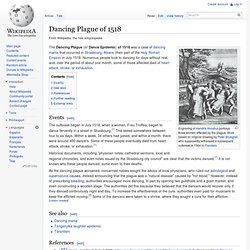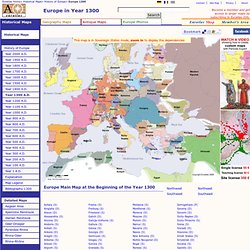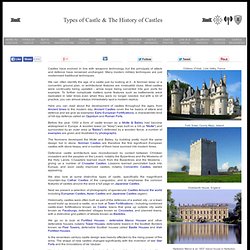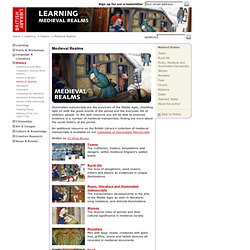

Dancing Plague of 1518. Engraving of Hendrik Hondius portrays three women affected by the plague.

Work based on original drawing by Peter Brueghel, who supposedly witnessed a subsequent outbreak in 1564 in Flanders The Dancing Plague (or Dance Epidemic) of 1518 was a case of dancing mania that occurred in Strasbourg, Alsace (then part of the Holy Roman Empire) in July 1518. Numerous people took to dancing for days without rest, and, over the period of about one month, some of those affected died of heart attack, stroke, or exhaustion. Events[edit] The outbreak began in July 1518, when a woman, Frau Troffea, began to dance fervently in a street in Strasbourg.[1] This lasted somewhere between four to six days. Historical documents, including "physician notes, cathedral sermons, local and regional chronicles, and even notes issued by the Strasbourg city council" are clear that the victims danced.[1] It is not known why these people danced, some even to their deaths. See also[edit] References[edit] External links[edit] Making history interesting since 2010.
Medieval England - History. The Britannia Lexicon. Have you always wanted to travel back in time to the Middle Ages but were hesitant because you didn't speak the language?
Presenting the Britannia Lexicon of strange legal, feudal, chivalric, monastic, military and architectural terms to help you understand what those guys back then were really trying to say. In addition, we will soon be including lengthier entries on particular events, wars, movements and organizations, called "Sidebars of History" which will give a more in-depth view of life, politics and religion in medieval Britain. Just click a letter below to begin. Periodis Web - Map of Europe in Year 1300. This map is in Sovereign States mode, zoom in to display the dependencies.

Edmund Blair-Leighton: The Accolade. World History: Medieval History: Britain: The Domesday Book. Books tagged medieval history. The Chivalry Bookshelf: Arms & Armour, Medieval History, Swordsmanship. TimeRef - Medieval and Middle Ages History Timelines - Medieval Life. Sex, Society, and Medieval Women. Types of Castle, Chateau Fort and Manor House and History of Castles.
Castles have evolved in line with weapons technology, but the principals of attack and defence have remained unchanged.

Many modern military techniques are just modernised traditional techniques. We can often identify the age of a castle just by looking at it . A Norman keep or a concentric ground plan, or architectural features are invaluable clues. Most castles were continually being updated - arrow loops being converted into gun ports for example. To further complicate matters some features such as battlements were replicated in later times even when they were no longer needed, but with a bit of practice, you can almost always immediately spot a modern replica. Here you can read about the development of castles throughout the ages, from Ancient times to the modern day. Before the year 1000 a form of castle known as a Motte & Bailey had become widespread in Europe. The Shapes of Medieval Swords. Medieval Sword Shapes - Their unique shapes and changes over the centuries The Shapes of Medieval Swords Swords from the medieval Period went through some wonderful changes as the tools and technology of metal working changed.

This change is also nicely seen in cultural differences in the swords. Periodis Web - Map of Europe in Year 1200. BUBL LINK: Medieval history. V&A and The National Archives. Domesday Book. On 5 January 1066, Edward the Confessor, the King of England, died.

Harold Godwin was crowned King of England. A Medieval Mystery. This lesson is suitable for KS3 History Unit 19: 'How and why did the Holocaust happen?

' and could also be used to support Citizenship at KS3 Unit 4: 'Britain - a diverse society? '. The cartoon depicts the profoundly negative way in which Jews were viewed in 13th century England. Their situation did not improve. The Day After... Project - Why were there executions in Bury St. Edmunds? (1381) Medieval Realms. Illuminated manuscripts are the survivors of the Middle Ages, shedding light on both the great events of the period and the everyday life of ordinary people.

In this web resource you will be able to examine evidence in a number of medieval manuscripts, finding out more about the social history of the period. An additional resource on the British Library's collection of medieval manuscripts is available on our Catalogue of Illuminated Manuscripts. Written by Dr Alixe Bovey. Towns The craftsmen, traders, temptations and dangers, within medieval England’s walled towns Rural life. Funny Historical Facts on Life from the Brobdingnagian Bards. Books and Films - Terry Jones' Medieval Lives. Internet History Sourcebooks. Internet Medieval Sourcebook Full Text Sources Guide to Contents The structure of this section of the Sourcebook is as follows.

You can browse through the entire list, or jump directly to the part that interests you by selecting the underlined links. Main Page will take you back to Sourcebook main page. WarsOfTheRoses.com - Wars of the Roses. EyeWitness To The Middle Ages and Renaissance. Life in a Christian Monastery, ca. 585"When he was dead his body was not placed with the bodies of the brethren, but a grave was dug in the dung pit, and his body was flung down into it. . .

" Crime and punishment in a medieval monastery: the monastery's Abbott provides insight into the monastic life. Www.timeref.org. Medieval Castle History, Design of Medieval Castles, Haunted Castles: www.medieval-castle.com.